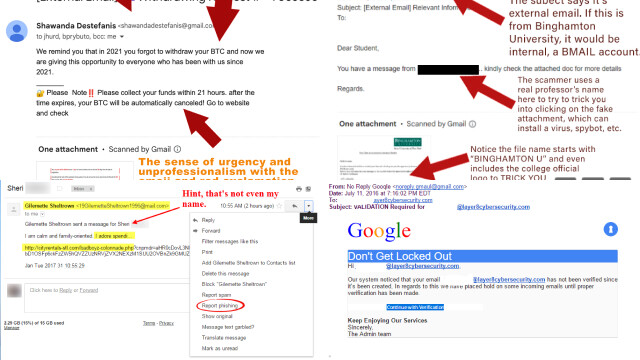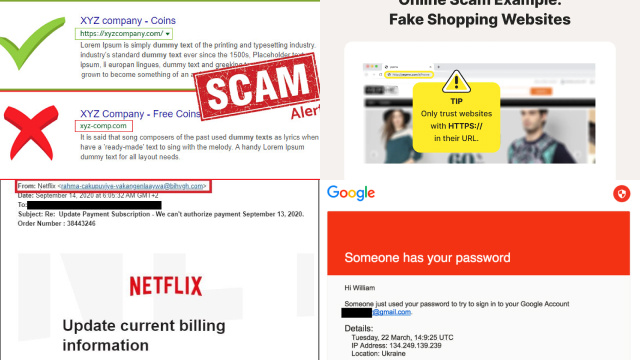What are Scam Websites?
Scam websites are fraudulent websites designed to deceive and defraud unsuspecting users. These websites often appear legitimate and may imitate the look and feel of reputable sites to trick users into providing sensitive information or making payments. Scam websites may be used for a variety of illegal activities, such as phishing, identity theft, and financial fraud.
Scammers may use a variety of tactics to lure users into visiting their websites, including email and social media campaigns, fake advertisements, and search engine manipulation. Once a user visits a scam website, they may be prompted to provide personal information, such as usernames, passwords, and credit card details. Scammers may also use the website to install malware or viruses on the user’s computer.
It’s important for users to be aware of the risks associated with scam websites and to take precautions to protect themselves online.
Types of Scam Websites
There are several types of scam websites, each designed to deceive users in different ways. One common type of scam website is the phishing site, which mimics the appearance of a legitimate site and tricks users into providing personal information, such as usernames and passwords. Other types of scam websites include fraudulent online stores that sell fake or counterfeit products, investment scams that promise high returns with little risk, and tech support scams that trick users into paying for unnecessary repairs or services.
Another type of scam website is the fake charity site, which claims to collect donations for a worthy cause but instead funnels the funds to the scammer’s own pockets. Finally, there are also malware-infected sites that install viruses or other malicious software on users’ computers. It’s important to be aware of the different types of scam websites in order to recognize and avoid them.
Common Features of Scam Websites
Scam websites are designed to deceive unsuspecting individuals by using various tactics. Some of the most common features of scam websites include offering products or services that are too good to be true, using fake testimonials or reviews to generate trust, requesting personal information, and using high-pressure sales tactics.
Scammers may also use URLs that are similar to legitimate websites to trick people into thinking they are on a trustworthy site. They may also use phishing emails to lure individuals to their fake websites, which can infect their devices with malware or steal personal information.
It’s important to be aware of these common features of scam websites and to exercise caution when browsing the internet. Always do your research, check for reviews and feedback, and verify the legitimacy of a website before sharing any personal or financial information. By staying vigilant, you can protect yourself from falling victim to these scams.
How Scam Websites Operate
Scam websites operate by using a variety of tactics to trick unsuspecting individuals into sharing their personal or financial information. One common tactic is to create websites that appear to be legitimate, offering products or services at extremely low prices or with promises of high returns on investments.
Scammers may also use phishing emails to lure individuals to their fake websites. These emails may appear to be from a legitimate source, such as a bank or government agency, and may request personal information or prompt the recipient to click on a link that leads to a fake website.
Once on the fake website, scammers may use high-pressure sales tactics or request payment for products or services that never actually get delivered. They may also use malware to infect the user’s device and steal sensitive information.
To avoid falling victim to scam websites, it’s important to always verify the legitimacy of a website before sharing any personal or financial information. Look for reviews, check the website’s URL for any variations or misspellings, and be wary of any unsolicited emails or messages requesting personal information.
Impacts of Scam Websites
Scam websites can have serious impacts on individuals and organizations alike. They can lead to financial losses, identity theft, and other forms of cybercrime. Scammers may steal personal information such as names, addresses, and financial details, which can be used for fraudulent purposes.
Victims of scam websites may also experience emotional distress, as they may feel violated and vulnerable after falling for a scam. Additionally, organizations may suffer reputational damage if their customers fall victim to scams that are associated with their brand or services.
In addition to these individual impacts, scam websites can also have wider societal impacts. They can contribute to a lack of trust in online transactions, which can harm the growth of e-commerce and online business. They can also have negative impacts on law enforcement, as resources are required to investigate and prosecute scammers.
Overall, the impacts of scam websites can be far-reaching and can cause significant harm to individuals and society as a whole. It’s important to stay vigilant and take steps to protect yourself from falling victim to these scams.
How to Identify Scam Websites
Identifying scam websites can be challenging, as scammers are often skilled at creating sites that appear legitimate. However, there are some key indicators that can help you identify a scam website.
First, look for spelling and grammar errors on the website. Legitimate websites typically have a high level of attention to detail and are well written. Scam websites, on the other hand, may have numerous errors and inconsistencies.
Second, be wary of websites that offer products or services at prices that are significantly lower than other websites. This could be a sign of a scam.
Third, check the website’s URL. Scammers often create URLs that are similar to legitimate websites but with slight variations. For example, they may use a .co domain instead of a .com domain.
Finally, look for reviews of the website. If the website has few or no reviews, this could be a red flag. Additionally, if the reviews seem too positive or are all written in a short period of time, this could be a sign of fake reviews.
By being aware of these indicators and taking the time to verify the legitimacy of a website, you can protect yourself from falling victim to scam websites.
Tips for Avoiding Scam Websites
To avoid falling victim to scam websites, there are several tips you can follow.
First, be cautious when clicking on links in emails or on social media. Scammers may use these links to lead you to a fake website.
Second, do your research before making a purchase. Check the website’s reviews and ratings, and search for any complaints or negative feedback.
Third, be wary of websites that offer products or services at prices that are significantly lower than other websites. This could be a sign of a scam.
Fourth, look for security features on the website, such as SSL encryption or a privacy policy. Legitimate websites will typically have these features in place.
Finally, trust your instincts. If something seems too good to be true, it probably is. If you’re unsure about a website, it’s better to err on the side of caution and avoid making a purchase.
By following these tips, you can reduce your risk of falling victim to scam websites and protect your personal and financial information.
Best Practices for Staying Safe Online
In today’s digital age, staying safe online is more important than ever. Here are some best practices to help you protect yourself and your information:
First, use strong, unique passwords for all of your online accounts. Avoid using the same password for multiple accounts, and consider using a password manager to keep track of your passwords.
Second, be cautious when sharing personal information online. Avoid posting sensitive information such as your full name, address, or financial information on public forums or social media.
Third, keep your software and security tools up to date. This includes regularly updating your operating system, antivirus software, and web browser.
Fourth, use two-factor authentication whenever possible. This adds an extra layer of security to your accounts and makes it more difficult for hackers to gain access.
Finally, be aware of the latest scams and phishing attempts. If something seems suspicious, take the time to investigate before clicking on any links or providing any information.
By following these best practices, you can stay safe online and protect your personal and financial information from cyber threats.



